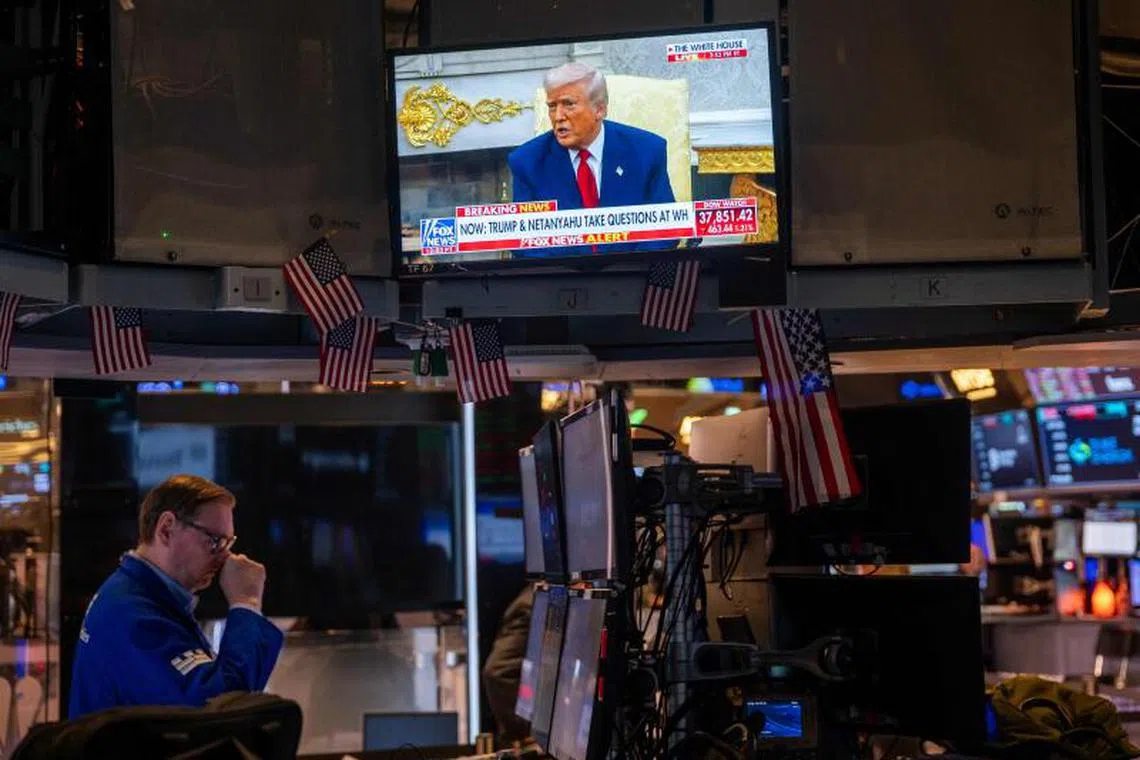Global markets convulse as tariff chaos erases $13 trillion from stocks
Sign up now: Get ST's newsletters delivered to your inbox

A monitor displays a S&P 500 ETF SPY chart on the floor of the New York Stock Exchange in New York, on April 7.
PHOTO: BLOOMBERG
Follow topic:
NEW YORK – The market chaos unleashed by US President Donald Trump’s trade war continued for a third day as stocks, bonds and commodities all swung wildly, buffeted by both fears of a recession and speculation the financial damage will drive him to change course.
The darkening global outlook hammered markets in Asia and Europe, extending a slide that erased roughly US$10 trillion (S$13 trillion) from equity markets worldwide, the S&P 500 opened sharply lower, only to briefly spike as rumours raced across trading floors that Mr Trump was poised to delay his tariffs. But prices sank again as those hopes faded – and by late morning Mr Trump was threatening to escalate his fight with China if the country doesn’t rescind its retaliatory tariffs.
Volatility convulsed other markets as well, with traders continuing to price in a high risk of a global recession. Oil prices dipped. The VIX Index – known as the fear gauge – spiked to pandemic-era levels. Treasuries weren’t much of a haven either: yields on longer-dated bonds surged, underscoring the risk that tariffs could sink the economy and worsen the government’s finances.
Those expectations prompted traders to boost bets that the Federal Reserve will enact as many as five quarter-point rate cuts this year to offset the toll – even after Chair Jerome Powell indicated that he’s in no rush to resume easing as the trade-policy shift threatens to spark another bout of inflation.
Put together, it amounted to yet another exhausting, topsy-turvy day in financial markets, and one where traders were looking for any hint, however small or fleeting, of a reprieve.
“Always be wary of extreme moves in a selloff like this,” said Mr Steve Chiavarone, head of multi-asset group at Federated Hermes. “Up moves aren’t the all clear, down moves aren’t Armageddon – and headlines fly around like crazy. What we need to see in the coming days is a policy response of some kind – a deal being struck with a key partner, an implementation pause, a Fed move, real progress on tax cuts.”
Mr Trump and his aides over the weekend showed little indication of changing course, downplaying the market’s slide as a short-term cost of a plan they say will bring jobs back to the US and rejuvenate the economy. Yet on April 7, markets hung on that possibility, at least temporarily halting the stock market’s worst slide since the pandemic hit the US in 2020.
Mr Trump has both seemed to stick to his resolve and indicate he’s willing to negotiate. On Truth Social on April 7, he welcomed the drop in oil prices and bond yields, and again called on Mr Powell to cut interest rates. He also said “countries from all over the world are talking to us,” and then later threatened to raise tariffs again on China, raising concerns about an escalating cycle.
The brief halt to the stock selloff was a welcome respite after markets slid around the world. China was particularly hard hit
Europe’s Stoxx 600 Index plunged to the lowest since December 2023 and Germany’s DAX Index briefly sank 10 per cent before recovering. Defence companies, some of the best-performing stocks this year, suffered some of the biggest losses as investors built cash by selling winners.
“Crazy volatility today,” said Mr Chris Zaccarelli, chief investment officer at Northlight Asset Management. “No one knows when – or how violent – a turning point will be when stocks eventually bottom.”
In the US, Wall Street luminaries including money managers Bill Ackman and Boaz Weinstein and JPMorgan Chase & Co CEO Jamie Dimon have started publicly flagging the risks posed by Mr Trump’s attempt to roll back the expansive cross-border trade that for decades has powered the global economy.
Those worries have driven even some of the more optimistic stock forecasters to start dialing back their calls. Oppenheimer & Co’s John Stoltzfus – the biggest bull among strategists until March – became the latest to slash his year-end target on the S&P 500, to 5,950 from 7,100. At RBC Capital Markets, Lori Calvasina gave a more dire prediction, saying that the S&P 500 may fall as low as 4,200 if “full recession pricing takes hold.” That would mean a 17 per cent plunge from April 4’s close.

US President Donald Trump is displayed on a television screen as traders work on the floor of the New York Stock Exchange on April 7.
PHOTO: AFP
Nevertheless, the rapid-fire rally in markets was reassuring to some traders, who saw it as a sign that investors were willing to swoop back in and haven’t fully retrenched in fear.
“No one wants to miss a rally,” said Mr Steve Sosnick, chief strategist at Interactive Brokers. “The positive vibes proved to be fleeting, but it proved how desperate traders are for any sort of tariff relief.” BLOOMBERG

